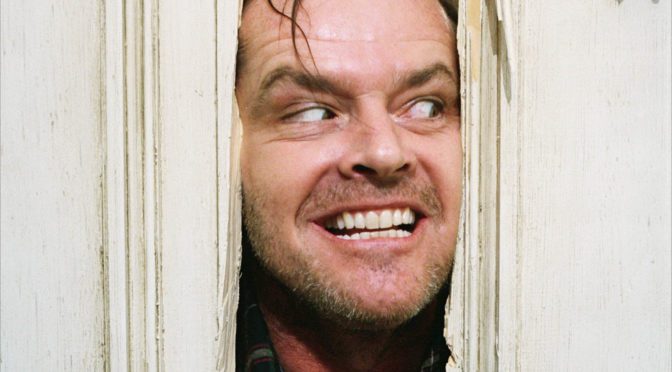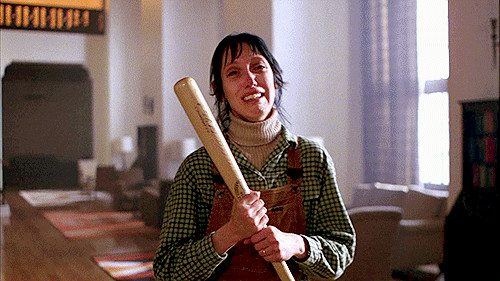“Places are like people. Some shine, some don’t.”
Halfway through watching The Shining, I started to wonder why I included it on this month’s viewing list. Not because it’s not great, mind you (it is), but because it’s been written about and analyzed so much that I don’t know what I could add to the conversation. Does the world really need 900 more words about The Shining? The film didn’t just contribute to the horror lexicon, it practically rewrote it.
Coming from a cerebral, dispassionate director like Stanley Kubrick, it should come as no surprise that The Shining is almost defiantly impersonal. Much to the chagrin of Stephen King, who wrote the novel the movie is based on, Kubrick jettisoned everything about the Torrance family that drew in King’s readers, leaving little else but profoundly damaged shells of people. It stands to reason that Kubrick was only interested in the framework of King’s novel, even going so far as to reject a script written by King. This puts The Shining in the strange position of being a great movie that is simultaneously a rotten adaptation (to borrow a phrase from The A.V. Club).
The film’s biggest departure from the book is that Jack Torrance (Jack Nicholson) is crazy almost from the get-go. Mention is made of his alcoholism, but the Shining film doesn’t become a full-on cautionary tale the way the Shining book does. It’s a minimalist film with a tiny cast set in one of Kubrick’s most expansive spaces. The Overlook Hotel seems to swallow the Torrance family whole, subsuming them. In many ways, the Overlook is Kubrick’s greatest set, not just because it’s his biggest, but because of how he bends and shapes it to his well.
Kubrick was an exacting, idiosyncratic director, a fascistic autocrat in the mode of Fritz Lang. Every seeming mistake in The Shining is intentional, and what adds to the film’s chilly allure is that Kubrick doesn’t explain half of them. Danny (Danny Lloyd) and his mother Wendy (Shelley Duvall) watch a TV that has no plug running to the wall; Jack observes them in miniature, navigating the hotel’s hedge maze; Danny rides his Big Wheel through the first-floor lobby, turns a corner, and finds himself on the second floor. Not only does the film not explain any of this, it doesn’t even bother to comment on it. Kubrick leaves bread crumbs all over the film, and they can be followed to almost any far-gone conclusion, but the pared-down explanation is: The Shining takes place in a world where nothing makes sense, nor does it have to.
No horror film in history has opened itself up to interpretation the way The Shining has. There’s a documentary by Rodney Ascher called Room 237, which I’d recommend checking out on Netflix; it features six unseen cinephiles dissecting the film and trying to decipher its real meaning. These range from the convincing to the dopey (apart from the presence of a labyrinth, I really don’t see how else Jack Torrance is like a minotaur), but for fans of The Shining it’s essential viewing.
And the thing is: those visual cues are there. If you want to believe The Shining is a comment on manifest destiny, you can look at all the Indian iconography in the hotel, or the poster’s tagline (“The Terror That Swept the West!”) or listen to Jack complain to spectral bartender Lloyd (Joe Turkel) about the “white man’s burden.” If you want to believe the film is Kubrick confessing to faking the moon landing, take a look at Danny’s sweater, emblazoned with the Apollo 11 spacecraft. I enjoy hearing these theories, and seeing the compilations of evidence, but to me it’s all so much addenda. The Shining can stand on its own with or without the theories surrounding it. Hell, The Shining can stand on its own without its source material, and that’s because of the world that Kubrick constructs.
With such a taskmaster behind the scenes, it’s truly incredible how little of The Shining feels like a film. The Steadicam glides through the hotel, running behind or in front of the characters like a phantom. Kubrick used some original music (by Wendy Carlos, composer of Tron and A Clockwork Orange) but for the most part relied on Bela Bartok’s foreboding “Music for Percussion, Strings, and Celesta” to set the mood. Kubrick’s use of iris fade-outs as transitions makes everything seem hazy and illusory; it’s as though we’re watching a bad dream, wondering if it’s Jack’s, Wendy’s, Danny’s, or ours.
This extends to the imagery as well. The Grady twins, the blood pouring from the elevator, the crone in room 237, the fellatio performed by a man in a dog suit, “All work and no play makes Jack a dull boy,” Kubrick’s use of primary color, especially red – these are what make The Shining such catnip for film buffs, so certain that each frame, each shot, has to be saying something, because it’s Kubrick, damn it! And therein is Kubrick’s greatest trick as a director. In trying to make sense of the imagery, of the geography, of the motivation, we find ourselves in thrall to the Overlook in much the same fashion as Jack Torrance.
The Shining endures because of the spell it casts. Look, for instance, at the scene where Wendy has to fend off Jack with a baseball bat. Guinness says Kubrick shot this 127 times, while the Steadicam operator puts it a mere 35-45. The number is irrelevant. See how Duvall’s arms wobble under the weight of the bat, see this woman in the middle of a genuine nervous breakdown, see the fear, exhaustion, and sadness in her eyes. When you see all that, you are not looking at Shelley Duvall. You’re looking at Wendy Torrance.
10/1: Dawn of the Dead (2004)
10/2: The Exorcist
10/3: Pontypool
10/4: Hocus Pocus
10/5: The Orphanage
10/6: Rosemary’s Baby
10/7: Alien
10/8: Scream series
10/9: Scream series
10/10: Cujo
10/11: The Cabin in the Woods
10/12: Pulse
10/13: The Babadook
10/14: Friday the 13th
10/15: The Last House on the Left (both versions)
10/16: The Thing (both versions)
10/17: Little Shop of Horrors
10/18: Hush
10/19: Silent Hill
10/20: The Shining
10/21: Funny Games (2007)
10/22: Evil Dead series
10/23: Evil Dead series
10/24: The Mist
10/25: The Ninth Gate
10/26: The Fly
10/27: A Nightmare on Elm Street
10/28: The Nightmare Before Christmas
10/29: 28 Days Later/28 Weeks Later
10/30: It
10/31: Halloween (either version)



